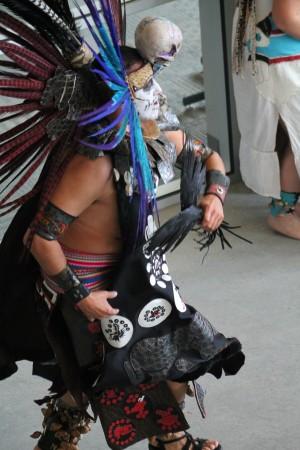
Some days, cultural anthropology instructor Willan Cervantes forgoes his suit and tie and wears the regalia of an Aztec dancer.
Cervantes and members of the Titlakawan dance club performed on Nov. 4 in the student center before students from Central Oregon Community College and Sisters high school.
“We’re going to have a cultural exchange,” Cervantes said to the crowd. “We are going to have a mutual agreement where I will respect you, and you will respect me.”
Led by Cervantes, four COCC students performed a ritual deeply rooted in Aztec history as they danced to the beat of a drum the way thousands before them have done. Students witnessed the physically demanding aspect of Titlakawan as Cervantes and his students danced for thirty minutes straight without any rest.
Those who practice Titlakawan know that there is more to this than feather adorned regalia and tribal face paint. Titlakawan is an Aztec word meaning “we all possess it.” Behind the dancing lies a complete lifestyle deeply rooted in the heritage of the Aztec people, where every component of the dancing symbolizes a part of life.
“We don’t consider what we do a show or entertainment,” Cervantes explained. “Each component of the dance represents a part of life.”
Cervantes explained how the different items used in the presentation had significant meaning. The command staff, for example, “represents stability and rectitude,” while the wings of a bird “represent the ability and connection to reach for the heavens.”
Together, these physical components help to develop a spiritual connection one experiences when enduring the physical demands of this ritual.
“People don’t last,” Cervantes said. “This tradition is tied to preparing men for war and women for childbirth, which is why this requires a lot of discipline and consistency.”
One person willing to accept the life of discipline and consistency is COCC student Isaiah Spence. Spence first came into contact with Cervantes and the Titlakawan dance group three years ago.
“I have been to a lot of powwows and have seen a lot of different dances,” Spence said, “but I knew this was different.”
Two years later Spence approached Cervantes with the interest of joining Titlakawan. Cervantes proceeded to take Spence under his wing along with his other students and Spence began his journey into a new life. He transitioned from being the group’s drummer into one of the dancers. After being involved in the group for one year, Spence has already began to feel the spiritual impact of Titlakawan on his life.

“It became something I practice every day,” Spence said.
The spiritual connection Spence is experiencing is a familiar feeling to Cervantes, who has been dancing for 17 years.
“It isn’t a strict way of life, but you hold yourself accountable,” Cervantes explained to the group. “[In our society] we focus on what makes us feel good and not on the core values of transcendental beliefs labelled as spirituality.”
Emily Frances Kalei
The Broadside













